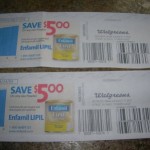If you're new here, you may want to subscribe to my RSS feed. Thanks for visiting!
If you’re new to using coupons, you may be confused by terms such as “stacking” and “overage” that more seasoned couponers throw out!
Stacking refers to using a store coupon and a manufacturer’s coupon together for greater savings! Although you can only use one manufacturer’s coupon per item, some stores also have special store coupons and they will allow you to use their store coupons with a manufacturer’s coupon!
The stores that come to mind that offer special store coupons include: Publix, Safeway, Target, and Walgreens. You can find the Target coupons online (visit their website and scroll down to the bottom of the page where there is a link that says “Coupon”) and they also sometimes send out special mailers. Safeway has “super coupons” that are considered store coupons in their weekly ads. Walgreens typically has store coupons in their weekly ad. They also have a monthly coupon book that is usually found at the front of the store in the same area where the weekly ads are kept. In addition, they often have additional specialized coupon books. An example is the Infant Care booklet that is out currently.
PLEASE NOTE: There may be other stores that provide store coupons and allow stacking. These are just the stores that I am familiar with!
Overage means that your coupon (or combination of store and manufacturer’s coupons) is more than the amount of the items that you are purchasing. Some stores will allow you to get cash back in these situations! Walmart is the store that I can think of off the top of my head. This is rare right now. Most stores will adjust the amount of the coupon down to the amount of the item being purchased. For example, if you are purchasing an item that is $.97 and you use a $1 coupon, they would adjust the amount of the coupon down to $.97.
In some cases, stores will not give you cash back, but you can apply the “overage” to other items in your cart. This is especially true if you are combining store and manufacturer’s coupons. If you are combining store and manufacturer’s coupons in a situation that would result in overage, make sure you are purchasing other items to “cover” the overage. Also, always make sure that you give the manufacturer’s coupon first and the store coupon last.
For example, let’s say that Walgreens has Colgate toothpaste on sale for $1.97 and they have a $1 store coupon in their monthly coupon book and you also have a $1 manufacturer’s coupon.
Here’s the breakdown of how this would work:
Buy Colgate toothpaste – $1.97
Use $1 manufacturer’s coupon (give this first!)
Use $1 Walgreens coupon (give this last!)
Final Price = $.03 overage (This will only “work” if you have other items you are purchasing to “cover” the overage! If you aren’t buying other items, the coupons would beep and they would adjust the price down)
*This post may contain affiliate links. Please refer to my disclosure policy for more information.















[…] Quaker granola bars never last long in my house and the deals are hard to come by, so I am excited about this one! Right now when you stack the Target coupon and the manufacturer’s coupon, you can get Quaker granola bars for just $.92 after coupons! (If you’re not familiar with “stacking” check out this post here!) […]